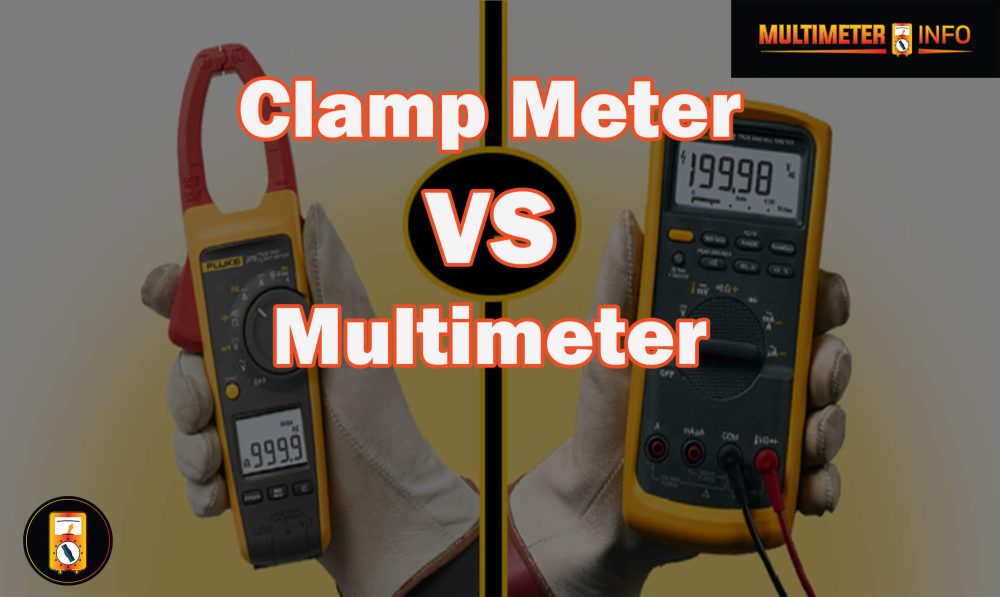Are you looking to do some electrical work around the house? It can be intimidating to tackle a big project, so having the right tools is essential. One of the most important decisions is whether you should get a clamp meter or a multimeter. Both are excellent pieces of equipment that will make it easier for measuring electricity and other forms of energy, but which one is better suited for your needs? In this blog post, we’ll explore what makes a clamp meter different from a multimeter and discuss in detail which tool might be the better choice for DIYers like yourself. Read on to find out more!

What is a clamp meter?
A clamp meter is an electrical instrument used to measure current and other values in a circuit without the need for disconnecting wires. It typically has jaws that can be clamped around a single conductor or multiple conductors, making it a great tool for measuring amperage in hard-to-reach places. In addition to current, clamp meters are also capable of measuring voltage, resistance, continuity, capacitance, and frequency.
Clamp meters provide a convenient way to quickly measure electrical parameters while avoiding the risk of any damage due to wiring connections being made and broken. They are commonly found in industrial settings but can also be beneficial for residential applications such as troubleshooting home wiring systems. As with any electrical instrument, proper safety protocol must be followed when using a clamp meter to ensure the user is protected from electrical shock.
By utilizing a clamp meter, electricians and technicians can easily diagnose issues in an electrical system without having to disconnect any wiring. With this knowledge, they are then able to make the necessary repairs with confidence. Clamp meters are a powerful tool for accurately measuring current levels and other parameters in various types of circuits. They provide a safe, efficient method for troubleshooting complex systems and should be part of anyone’s basic electrical testing arsenal.
How does a clamp meter work?
Clamp meters are specialized electrical testers that use a current-sensing device to measure the amount of electrical current in a circuit. The clamp meter is attached to a conductor, allowing it to measure an electric current without breaking the circuit. The clamp meter then uses this reading, combined with its internal circuitry, to display the AC or DC voltage level on its digital display.
Clamp meters are also convenient tools for troubleshooting and finding potential problems in circuits. They can measure both live and dead circuits, helping technicians check the accuracy of their wiring setup without having to shut off power or disconnect components. This makes them essential tools when dealing with live systems such as motor controls and alarm systems. Ultimately, clamp meters are incredibly useful devices that make electrical work much safer and easier.
In summary, a clamp meter is an essential tool for any electrician or technician working with electrical systems. By combining the convenience of a digital display with the accuracy of a current-sensing device, they provide an invaluable service when it comes to diagnostics and troubleshooting. With their help, technicians can quickly identify problems in circuits without having to shut off power or disconnect components. Ultimately, clamp meters are incredibly useful tools that make electrical work much safer and easier.
What is a multimeter?
A multimeter is a handheld device used to measure multiple electrical properties simultaneously. It can measure voltage, current, and resistance, among other values. Multimeters are essential for any electrician or electronics technician as they allow technicians to quickly troubleshoot and diagnose problems with circuits. Multimeters also provide important safety features that help protect users from potential electric shocks or power surges.
The two basic types of multimeters are analog and digital. An analog multimeter measures electrical properties using a traditional needle-style meter, while a digital multimeter uses an LCD display to show the results of measurements. Digital multimeters are often more accurate and easier to use than their analog counterparts and are typically preferred by experienced technicians.
The type of measurement being taken will determine which type of multimeter is best suited for the job. For example, precision voltage readings require a sensitive digital multimeter, while current readings may only require an analog one. Additionally, some advanced models combine both types of meters into one device for added flexibility and convenience.
No matter what type of multimeter you choose, it’s important to be aware of potential safety hazards when taking measurements in any environment. Be sure to familiarize yourself with the safety instructions of your multimeter and follow all safety protocols when taking measurements.
How does a multimeter work?
A multimeter is a tool used to measure electrical properties such as voltage, current, and resistance. It usually consists of two probes, one for measuring voltage (AC or DC) and the other for measuring current or resistance. The user attaches the probes to the circuit being tested and reads the values of an LCD screen.
The multimeter is equipped with multiple ranges which relate to the amount of current or voltage it can measure. This enables users to accurately measure different levels of electricity in any given situation. In addition, many multimeters also have additional features such as capacitance measurement, frequency measurement, temperature measurement, and diode testing capabilities.
To use a multimeter correctly, it is important to understand the basic principles behind the tool. The multimeter works by measuring the amount of current that flows between two points in a circuit. This is done using Ohm’s law, which states that voltage, current, and resistance are related to each other and can be used to calculate one from the other. By knowing this relationship, users can accurately measure all three values when using a multimeter.
A multimeter is an essential tool for electricians and DIYers alike as it allows them to quickly diagnose electrical issues and safely work with electricity. It is a convenient and user-friendly device that requires no prior knowledge or experience with electronics or electrical systems to operate correctly. Understanding how a multimeter works will help ensure the safe operation of electrical circuits around the home or workplace.
Differences between clamp meters and multimeters?
Clamp meters and multimeters are two different types of electrical testing tools that are used to measure various electrical parameters. Clamp meters are designed to measure the current in a circuit by clamping around one of its conductors. This is done by moving the clamp’s jaws around the conductor until it is closed and then opening it again to measure the current. Multimeters, on the other hand, can be used to measure voltage, current, and resistance.
When choosing which tool would best suit your needs, you should consider the types of measurements you intend to take. If only measuring current is required, then a clamp meter will be sufficient. However, if you need to measure multiple parameters such as voltage, current, and resistance, then a multimeter would be the better choice.
It’s important to note that clamp meters are not suitable for taking measurements from live circuits. Therefore, if you intend to take measurements on a live circuit, then it is best to use a multimeter or an appropriate test instrument designed for the purpose.
Ultimately, both clamp meters and multimeters have their advantages and disadvantages. The main differences between them lie in what they are designed to measure. Clamp meters are primarily used to measure current while multimeters can measure multiple parameters including voltage, resistance, and current. Depending on your needs, one tool may be better suited than the other. It is important to consider all of your options before making a purchase decision.
Frequently Asked Questions:
This is a difficult question to answer as it depends on the specific task for which you are using either tool. Generally speaking, however, if you need to measure current without breaking the circuit, then a clamp meter is the better choice. Clamp meters provide non-intrusive measurements and allow you to take readings safely in enclosed or awkward spaces.
On the other hand, multimeters are more versatile as they can perform both voltage and current measurements. Additionally, they have more features such as advanced digital readouts and data recording capabilities. So if you are looking for a multi-purpose tool that provides accurate readings and offers additional functionality then a multimeter may be the better option for you. Ultimately, it all comes down to what specific needs you require and what you will be using the tool for.
Most electricians use digital multimeters, which are designed to provide accurate measurements of current, voltage, and resistance in electrical circuits. Digital multimeters can also measure capacitance, temperature, frequency, and duty cycle. Professional electricians usually have a variety of high-quality multimeters to choose from depending on their specific needs. Popular brands include Fluke, Amprobe, and Klein Tools, all of which offer dependable performance with advanced features.
Yes, it can. Clamp meters are designed to measure both AC and DC amps when used correctly. The clamp meter has two jaws which allow one to measure the amount of current passing through a conductor. The jaws are placed around the wire or conduit without having to disconnect any wires or break any circuits. By doing this, it allows for the measurement of both AC and DC amps – as long as the range is within the capabilities of your clamp meter. It is important to note that different clamp meters have different amperage ranges, so it is important to check the ratings of your clamp meter before attempting a measurement.
Final Note:
When it comes to choosing between a clamp meter and a multimeter, there are several factors to consider. Clamp meters are more specialized than multimeters and may be better suited for specific applications, such as measuring current or sensing magnetic fields. Multimeters, on the other hand, offer more versatility as they can measure voltage, current, resistance, and more. Ultimately, the best choice will depend on the tasks being performed and which tool is best suited for that particular job. Regardless of which type of device you choose, both will provide accurate measurements for your project needs.





